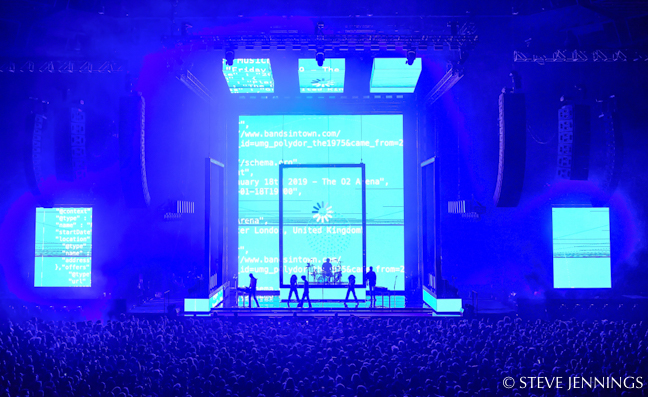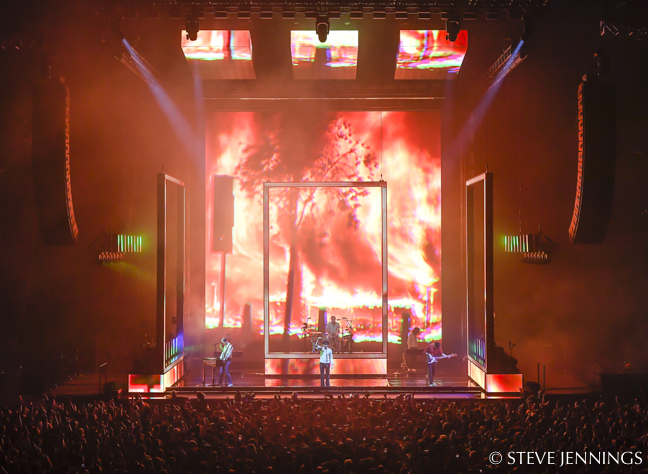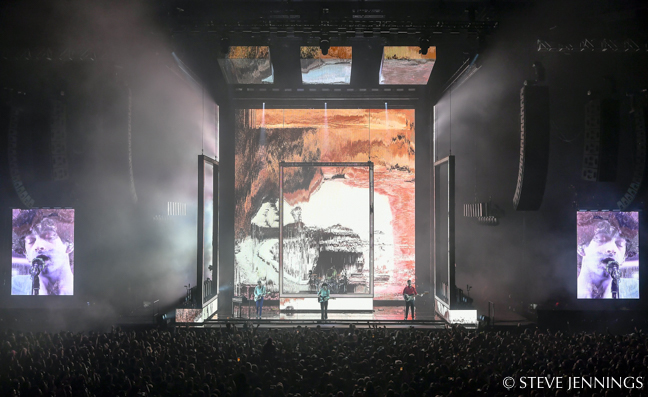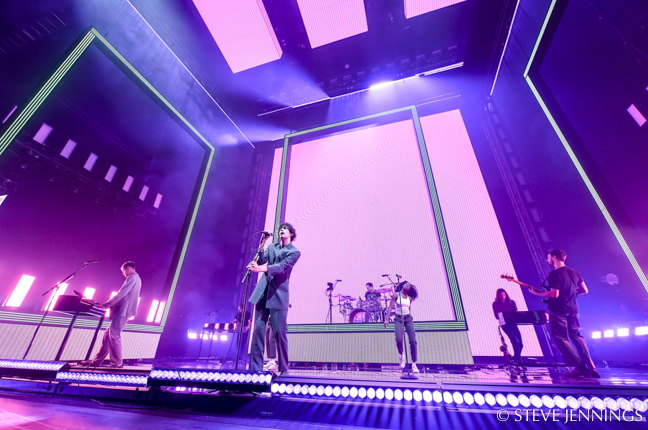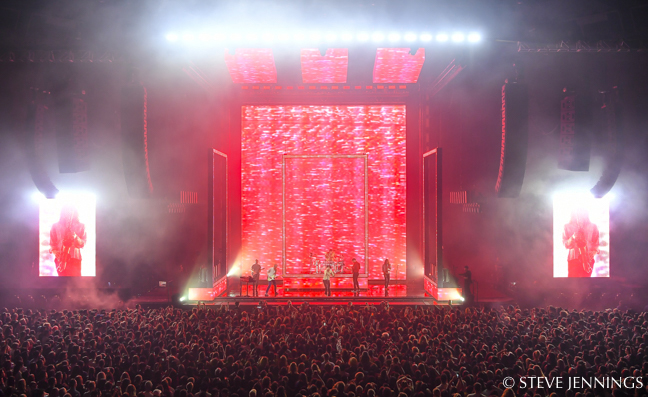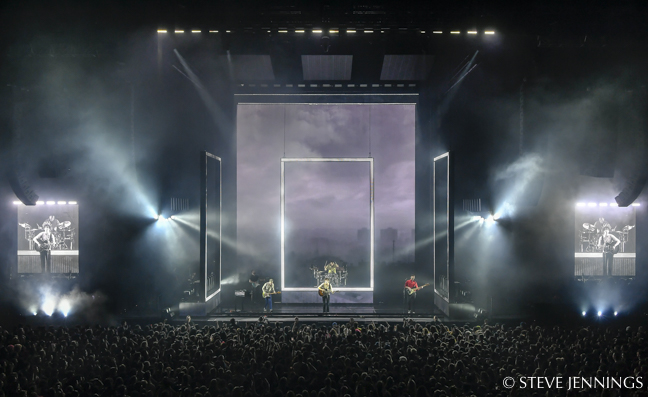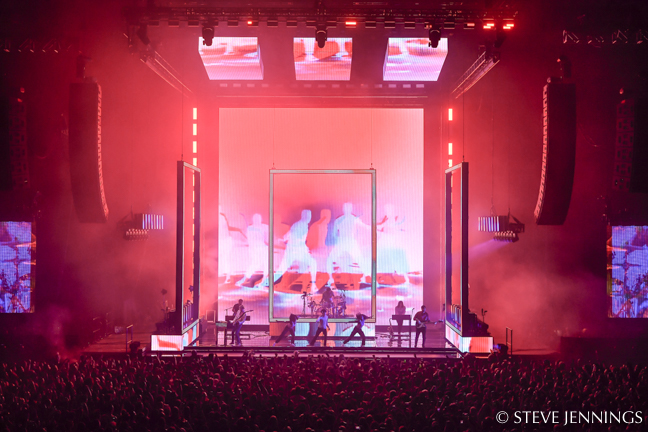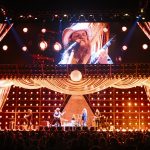
Pop/rock band The 1975, from Manchester, U.K., are out on tour in support of their third consecutive #1 album, A Brief Inquiry Into Online Relationships. We caught the band for a two-night stand in San Francisco. The band consists of Matthew Healy (lead vocals and rhythm guitar), Adam Hann (guitar), Ross MacDonald (bass), and George Daniel (drums). Band member Healy is also the creative director, working in the design process with Tobias Rylander, the conceptual, stage, show and lighting designer for the tour. We spoke to lighting director and programmer Darren Purves, video content creators Kerstin Hovland and Emery Martin of Electronic Countermeasures as well as video programmer Morgan Brown.
Tobias Rylander provides the band with bold architectural structure and strong video elements, and they help the band get the audience engaged right at the start. Rylander has three rectangular LED frames to surround the band along with three overhanging video cubes. The staging includes video mapped GLP Impression X4 Bars and SGM Q-10 fixtures. WinVision Air 9mm I-Mag screens add rich, saturated color content, where Rylander and his team have blended light and pixels for a cohesive design. With both light and blank space used effectively, Rylander has made the 3D framing space alter for a variety of atmospheres in light, shadow, contrasting pixels and band silhouettes, all for a very effective visual bending scope.

Pairing the Songs with Visuals
Lighting director and programmer Darren Purves notes how the visual design team took over the bands’ residential recording studio for two weeks to start their programming in previz. They then had another two weeks in production rehearsals at LH2 in London programming overnight, then rehearsing with the band through the day. “The band wanted to have a large ‘grab bag’ of potential songs to choose from and have the flexibility to swap these in and out of the set. In the initial list, we had around 25 songs programmed; I believe we’re now up to around 35.
“We spent lots of time timecoding the tracks, with the majority of cues automated. The timecode element is so important to the show — the line between lighting and video is so blurred and it gives you the ability to scrub the server delay out of cues, making sure the lighting and video hits are perfectly synced. As well as running the lighting and video from the console, I’m also calling lots of Kinesys and spot cues, so the timecode gives me the headspace to really concentrate on the show as a whole. For a couple of the tracks, we had a low res version of the video content created by Kerstin Hovland. We then used the bitmap engine in the MA to output this content to the lighting fixtures. It was really effective in making the video bounce out of the stage and fill the venues.
“Fortunately, Matt (Healy) and Tobias had quite a clear idea on what they wanted the show to be when I became involved. We sat down in the studio and went through his first concept and discussed what they were trying to create. We then spent some time adding some trusses and fixtures, making sure we had every angle covered, as well as a few discussions about the best fixture choices. Having worked together previously helps — I understand Tobias’s workflow and how he likes to create looks, meaning I can have everything I need quickly accessible when we program.
“I would like to add a big thank you to lighting and video crew chiefs Josh Barnes and Ed Lawlor and production manager Dermot Lynch for all of their hard work pulling this complex show together. And our account handlers Roy at Christie Lites and Stefaan at PRG.”

Creating the Video Content
Kerstin Hovland and Emery Martin of Electronic Countermeasures were brought into the fold. Both had worked with Rylander and The 1975 on their last tour cycle, their second tour with Rylander as production designer. “We had worked with Tobias previously on several other shows, and felt like we had a good relationship and complementary aesthetic to create together for an ambitious, sculptural design,” says Hovland. The design for the last tour used video content and light together to create three-dimensional forms. The current tour expanded upon the designs and techniques developed in the previous cycle to peer into the world behind the screen, metaphorically speaking. “The verticality of the physical LED set pieces mimics the screen-based mediation of reality through a mobile device and the video art was meant to be referential of both how we experience the world, and the band’s music through our interface with the screen.”
“Kerstin and I are artists who work across a plethora of mediums and started working together as Electronic Countermeasures in 2012,” says Emery Martin. “As Electronic Countermeasures, we’ve focused on creating dynamic and immersive visual environments for live events with a large emphasis on broadcast, touring musical acts, installation, opera, and theater. Both of us come from animation, art, computer programming, user experience, and music performance backgrounds, which provides a unique vantage that spans both the performer and designer lens to view any particular project through. Kerstin additionally brings an engineering and dance background, while I bring a traditional film and experimental sculpture perspective to the mix, which tends to enrich the influences we pull from.”

A Visual Language
Hovland says that the band, especially Matt Healy, bring a strong voice and perspective to the creative conversation. By the time they joined the process, they had been working with graphic designer and artist Samuel Burgess Johnson for the art surrounding the release of the album. “That conversation had been in play for several months before we joined, and they had already developed much of the visual language of the music and album. Having a strong foundation to work from and a clear concept from Matty’s perspective helps us to create the visual storyline of the world that the band is performing in.
“Tobias’ design for the last two tours have felt very much immersive for the audience, but especially encompassing of the band’s performance environment,” Hovland adds. “This tour’s design moves more fluidly between backdrop and light sculpture, whereas the last one was very environmental, so there was a lot of play between whether we were creating a graphic backdrop within that space or a kinetic light sculpture or a scenic environment. Matty’s desires for certain performative elements during the set shaped the development of each piece and how it interacted with the screens, lighting, and the band’s performance.”

“Piles of Prisms”
“Matty always has a strong voice in the mix, and simultaneously there’s moments where we’re just allowed to run with ideas or methods that are compelling, says Martin. “For instance, one of the updated looks from the previous tours is a live action piece that all revolved around prisms. The previous tour incorporated them as standalone prisms inhabiting the LED monoliths with a single round light source and under the camera hand manipulation performances of the prisms by me to fill out the upstage LED wall. This time around, there was a focus on sharp geometric light sources and fully populating the gigantic upstage LED wall with prisms, really exaggerating the hyper-real scale of the design. So, instead of shooting singular prisms, I went full out with piles of prisms of different sizes and sculpted rectilinear light sources from multiple angles, creating visual density to a point where you can’t tell where one begins, and one ends. Feels like it should be CG, but it’s real, and you can see the dust, the fingerprints, the scratches, and all the imperfections that ground you in the experience.”

A Library of Looks
Hovland says when working with Tobias and The 1975, the process is fairly fluid, in terms of what is created for the show. “It is rare that there is a distinct idea for a specific song when we go into rehearsals — rather, we have prepared a library of art that we can pull from and develop further onsite as the band refines the set list and we all learn the capabilities and surprises of the screens and lighting interactions. There have been looks we have loved that didn’t have a place in the current set that are still waiting for their moment, and things that we were certain were going to be big hits that somehow fell flat when seen in situ. The way we work on this tour allows for that to be an evolving conversation until we hit upon the look and motion that best represents the band’s intent and aesthetic for each song and for the overall arc of the set. To this end, very few pieces are fully rendered to the length of the track. Most of what we make for The 1975 is a kit of parts — elements that are pieced together during rehearsal, either in server or by me animating onsite. We have workstations in the room so I can be building new things or modifying existing parts of the kit to suit the creative needs during previz and technical rehearsals.”
Martin mentions that there are 55 distinct look families/songs. Some of these you won’t see in the show right now, but were built and might show up in the subsequent legs as the tour happens. “It’s more akin to a library, so when the set changes for a new leg, it’ll be like, ‘Oh, remember that thing we made that was stunning but didn’t have a place for it just yet, let’s do that now,’ so we do.”

An Inventive Process
Hovland says The 1975 are a fun act to work with because between them and Tobias, they are always looking for something completely different; something they haven’t seen before. “We get to pull a lot of things out of the toy box that we’ve always wanted to try but didn’t have a place for. They’re also comfortable with and committed to a longer creative process that allows for experimentation and a bit of risk-taking. As for working in the room, I have been able to move my workstation and process into the rehearsal space alongside Tobias, Morgan [Brown], Darren [Purves] and James [Valpy] so that we are all creating together in the same space, at the same time. This allows us to share ideas and come up with serendipitous blendings of video and light as we’re all working. It makes for a great collaboration and a cohesive show in the end. This also allows us all to work through technical as well as creative challenges in real time. I also had Emery back in the studio and a support team of animators back home to help make the evolving ideas in the room possible, as some of them required more resources and time than I had at my immediate disposal in the rehearsal space.”

Tools of the Trade
Software is really both conventional and experimental to a degree, notes Martin. “You have the usual suspects with After Effects for all the 2D work, conforming, and finishing passes for everything in the show. You have 3D looks from both Cinema 4D and also some from Notch. You have generative items hand coded and built in the open source programming language processing. You have conventional live-action tools like RedCine X Pro for conforming and doing first pass grades of all the RAW footage we shot on our RED along with FCP-X (don’t knock it — it’s fast and flexible). We also have the really crazy hybrids like the live-action photogrammetry piece we did for How to Draw that incorporated Meshlab, Blender, Notch, and After Effects. We take a very “any means necessary” approach with The 1975 and most of our shows.”
He adds, “Internally, we use [disguise] d3 Designer for previsualizing everything even though the show runs on Hippo. It’s super-important for us to be able to see how things are working in 3D space, as the show needs to look good for the majority of fans who are not sitting or standing dead center. In that way, we always approach things in a much more spatial, installation, sculptural manner, where it should still work as you walk around the piece, the stage, etc.” On the last two Martin had to work remotely, so he wasn’t in the room on site. It’s typically come down to shoots needing to happen, animators needed to be directed, or very complex pieces that required Martin with the full firepower of the studio at his disposal.

Updating the Vibe
As video programmer, Morgan Brown notes that the show is programed by Darren Purves mostly, but he’ll add some video to what Purves has come up with and stripe it to timecode. Once the marks are in the TC, it’s not that difficult, he says. “I would rather spend time in Angelic Studio than any venue in the world to make a show like this, and it just so happens we did. I think there is a certain vibe to this tour compared to the last one we did for this band. First class to spend the time and money on preparation, a lot of the creative part is making things fast. We need to program a look and then look at it, if we later want to change the song, it’s good to be faster the second time you make it. But you also become faster on the programming and servers.
“For the show, I monitor the Green Hippo zookeeper and mostly sort things out. We use as many layers as you can get out of a Taiga+ and there are a lot of parameters to play with, but after the initial setup cue is loaded, the servers are pretty much doing intensity stuff and a few effects here and there on different surfaces. We think it’s a cool way to build shows, and that’s what matters. It’s only a tool at the end of the day to make what Matty and Tobias have envisioned. We do have a lot of fun making this show, and these guys are the best I ever worked for. Once on the road, I just update the different shows we do depending on the venue size. This is by far the nicest touring family.”

The 1975
North American Tour 2019
Crew
Creative Director: Matthew Healy
Conceptual, Stage, Show & Lighting Designer: Tobias Rylander
Lighting Director, Programmer & Co-Lighting Designer: Darren Purves
Video Content Creators: Kerstin Hovland, Emery Martin, James Valpy, Ben Ditto, Samuel Burgess-Johnson
Video Programmer: Morgan Brown
Lighting Co: Christie Lites
Lighting Crew Chief: Josh Barnes
Lighting Tech: Ian McCarthy, Hadyn Williams, Martin Golding
Dimmers: Craig Hancock
Christie Lites Rep: Roy Hunt
Tour Manager: Maarten Cobbaut
Tour Manager Assistant: Amy Hills
Production Manager: Dermot Lynch
Production Coordinator: Cherie Breaux
Production Assistant: Willow Findlay
Stage Manager: Jack Dunnett
Video Cos: Christie Lites, PRG
Video Engineer / Crew Chief: Ed Lawlor
Camera: James Valpy (Director), Lena Wynants (Supervisor)
LED Techs: Jak Gambino, Luke Butler, Conor Downy, Graham Lambkin
Video Content Co: Electronic Countermeasures
Automation Co: Kinesys
Automation Crew: Jimmy Johnson (Programmer/Operator), Sam Jackson (Rigger)
Rigging Co: Christie Lites
Riggers: Simon Lawrence (Head), Phil Taylor (Mother Grid)
Cub Set Carpenter/Cube LED: Ben Clarkson
Set Carpenters: Dale Small (Crew Boss), Ryan Lucas, Conor Catterall, Jonathan Klose
Set & Staging Co: Brilliant Stages/Toby Van-Hay, Adam Bullet Bettley

Gear
Lighting:
1 grandMA lighting console
38 Claypaky Sharpy Wash 330’s
135 GLP Impression X4 Bar 20’s
59 GLP JDC1 LED Strobes
4 Martin MAC Viper Performances
5 Robe BMFL Blades
60 SGM Q-10 Strobes
Video:
451 WinVision Air 9mm panels (600mm x 1200mm)
202 WinVision Air 9mm panels
288 RD Blade HD
48 RD Blade HD Mini
More 2019 tour photos of The 1975 by Steve Jennings:























